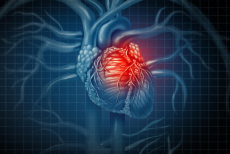

Myocardial Infarction (Heart Attack) and Angina
The coronary circulation is the blood flow that supplies blood and oxygen to the heart. Only 1/10mm of endocardial surface obtain nutrients from blood in the heart chambers, the rest relies on coronary circulation. There are large arteries on the surface of the heart and smaller arteries that penetrate into the heart muscle. The resting coronary blood flow is 225ml/min, where approximately 70% of blood oxygen is removed as it flows through the heart. The incidence rate of heart attacks are higher in men than women, with an occurrence of roughly 123,000 a year in the UK.
Coronary blood flow is reduced by fall in arterial pressure, a decrease in diastolic intervals, and a rise in diastolic end pressure. Coronary artery vasodilators are substances that can cause widening of blood vessels such as bradykinin (a peptide inflammatory mediator), and adenosine from ATP. A decrease in oxygen levels releases vasodilator substances. Atherosclerosis is a major cause of ischemic heart disease, it is a disease where plaques in the heart vessel lumen and invaded by fibrous tissue and/ or are calcified causing hardening of the blood vessels.
Myocardial infarction vs. stable angina vs. unstable angina
Stable angina is not a disease but a symptom of an underlying heart condition. Atherosclerotic plaques form in the blood vessels, which can cause pain in the chest due to lack of oxygen rich blood following the plaque. Unstable angina is where along with the atherosclerotic plaque there is a partially occlusive thrombus that almost blocks the blood vessel lumen. So, unstable angina is more severe. Myocardial infarction occurs when there is a fully occlusive thrombus so the vessel is completely blocked.
Major risk factors of angina
Hypertension (high blood pressure)
Obesity
Smoking
Physical inactivity
Diabetes
Where does the thrombus come from?
Atherosclerotic plaques that cause hardening of walls cause dysfunctional endothelium and reduce vasodilator effects of vessels therefore cause vasoconstriction. If the plaque ruptures this leads to turbulent flow, release of tissue factors, intraplaque hemorrhages and exposure of subendothelial collagen. As a result,platelets are activated and aggregate and coagulates are activated. All of this combined leads to a coronary thrombus producing occlusion.
The myocardial infarction process begins where blood flow ceases beyond the occlusion (except collateral blood flow). Collateral flow overfills with stagnant blood and oxygen is used up by cells leaving deoxygenated haemoglobin. Vessel walls become highly permeable and leak fluid, as a result muscle cells swell and within 20 minutes the muscle cells die.
Ischemia leading to cell death
Ischaemia leads to lack of oxygen supply. Therefore, anaerobic metabolism can occur, producing H+ ions, denaturing proteins (a contributing factor to cell death.) Low oxygen levels leads to decreased ATP, impairing Na+ K+ ATPase. Impaired Na+ K+ and ATPase has multiple effects that lead to cell death:
Decrease in membrane potential leading to cardiac arrhythmias
Intracellular edema (swelling)
Intracellular Ca2+ ion levels rise activating proteases and lipases
There are very few collateral branches in the normal heart. Collateral vessel development is too slow in times of rapid collusion.
image- https://www.medicalnewstoday.com/articles/323451.php

0 Comment:
Be the first one to comment on this article.